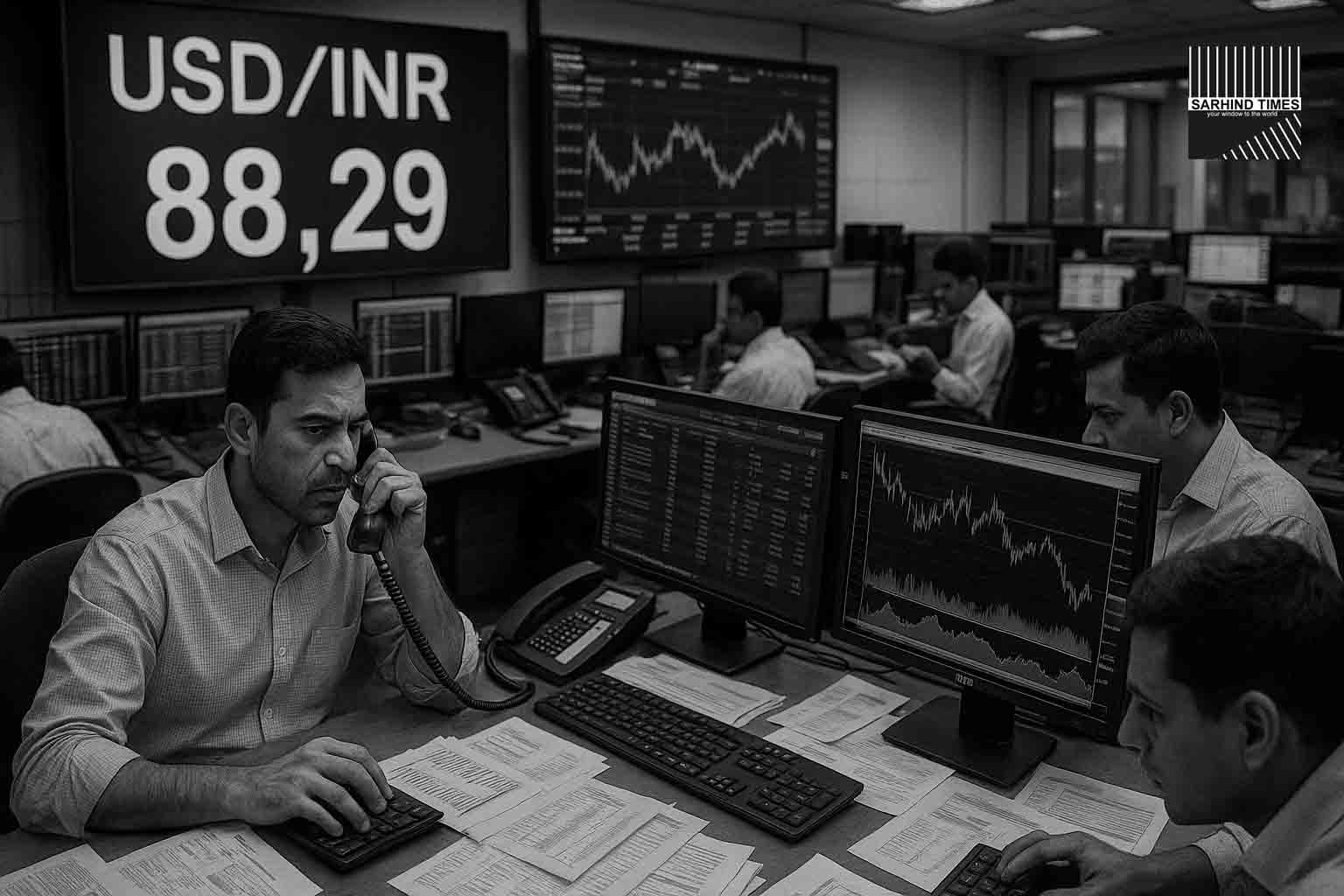The Indian rupee spent Tuesday morning trading around ₹88.29 to the US dollar, a level that highlights both the resilience and fragility of Asia’s third-largest economy. While volatility was modest, the move comes against a backdrop of equity outflows, visa fee uncertainties impacting IT sentiment, and crude oil fluctuations that keep importers cautious.
The rupee’s performance has become a barometer not just of financial stability, but of India’s positioning in a volatile global macro environment. Traders, policymakers, exporters, and households alike have a stake in how the INR navigates the coming weeks.
Monday’s Context: Equities, Visa Fees, and Outflows
The rupee’s jitters followed a risk-off Monday in Indian equities, where benchmarks slipped ~0.5%. Traders cited US visa fee hikes—a structural cost hit for IT outsourcers—as weighing on inflows. Coupled with FII outflows, the rupee flirted with new lows but held in range thanks to counterbalancing factors.
- Visa Fee Worries: Analysts say higher visa costs dampen sectoral earnings expectations, limiting fresh equity inflows.
- FII Activity: Outflows continued modestly, pressuring INR demand.
- Domestic Sentiment: Banks and autos offset some of the IT drag, reducing panic.
Current Dynamics: Why 88.29 Matters
The 88.20–88.40 zone has emerged as a critical near-term band:
- Support: Exporters actively hedge at these levels, locking in revenues.
- Resistance: Importers stagger cover, hoping for dips to reduce landed costs.
- Psychological Threshold: 88+ is seen as testing the RBI’s tolerance for currency weakness.
Traders describe this as a “wobbly but orderly” market—range-bound, but vulnerable to sudden spikes if oil or US yields shift.
The Oil Connection: Crude as a Perennial Risk
Brent crude remains one of the strongest external levers on INR. At ~$94/barrel, it keeps:
- OMCs (oil marketing companies): Under pressure as dollar demand rises.
- Aviation: Airfare costs sensitive to jet fuel.
- Inflation: Imported inflation risk if pass-through rises.
A single $10 move in crude can translate into billions in additional import bills, widening India’s trade deficit and shaking rupee sentiment.
Intervention Watch: RBI’s Quiet Hand
Speculation around RBI’s role never goes away. Market participants believe:
- Spot and forwards: Interventions cap volatility, not direction.
- Reserves cushion: With ~$650B in reserves, RBI has room to smooth disorderly moves.
- Tolerance band: Analysts peg RBI’s informal comfort at ~87–89/USD.
For now, global dollar strength (DXY) and oil trends remain more decisive than intervention chatter.
Exporters vs Importers: Different Games
- Exporters: IT, pharma, and textiles front-loaded hedges ahead of quarter-end. This locks in revenues and supports corporate guidance.
- Importers: Aviation, oil refiners, and electronics stagger cover, waiting for dips. Some are using options to balance exposures.
This push-pull creates the range-bound dynamic that keeps INR from freefall.
Bond & Macro Backdrop: Why INR Isn’t Collapsing
Bond dealers noted stable yields despite currency jitters. Why?
- Services Surplus: IT and business-process exports generate steady inflows.
- Remittances: NRI inflows remain strong, particularly from the Gulf.
- Macro Stability: India’s GDP growth >6%, inflation moderating, and banking sector healthy.
These structural supports help keep INR “weak but not broken.”
Global Forces in Play
- DXY Strength: US dollar remains firm on rate-hike expectations.
- US Yields: Elevated Treasuries make emerging-market carry less attractive.
- China Slowdown: Spillovers affect Asian FX sentiment.
Thus, INR is part of a broader EM currency narrative—not an isolated story.
Technical Picture
- Immediate resistance: 88.40–88.50.
- Support: 87.80–88.00.
- Medium-term: Risk of testing 89 if crude spikes, unless RBI intervenes.
Traders suggest option strategies to play volatility rather than outright directional bets.
Expert Voices
- Currency Strategist, Mumbai Bank: “INR’s weakness is less about India and more about global dollar strength. Domestic macros remain intact.”
- IT Sector Analyst: “Visa fee hikes are sector-specific, but given IT’s weight in exports, the sentiment spillover is real.”
- Bond Dealer, Delhi: “Yields are stable, showing confidence in macro support. The rupee is weak, not worrisome.”
Investor & Household Implications
- Investors: Portfolio volatility; hedging gains offset spot pain.
- Corporates: Importers must refine cover strategies; exporters enjoy margin tailwinds.
- Consumers: Imported electronics, fuel, and travel could see cost creep if INR sustains above 88.
- NRIs: Remittances fetch higher INR, boosting household incomes back home.
The Road Ahead
Short term, INR is tied to:
- Rupee vs Oil: A crude spike pushes INR weaker.
- Visa Overhang: IT flows remain sluggish until clarity emerges.
- Global Macro: DXY trajectory + US data prints.
Medium term, macro supports—services exports, remittances, strong reserves—mean INR is unlikely to spiral, but range-trading with volatility is the base case.
#Rupee #USDINR #Forex #Oil #FIIFlows #INR #Economy #Markets #Currency






















+ There are no comments
Add yours